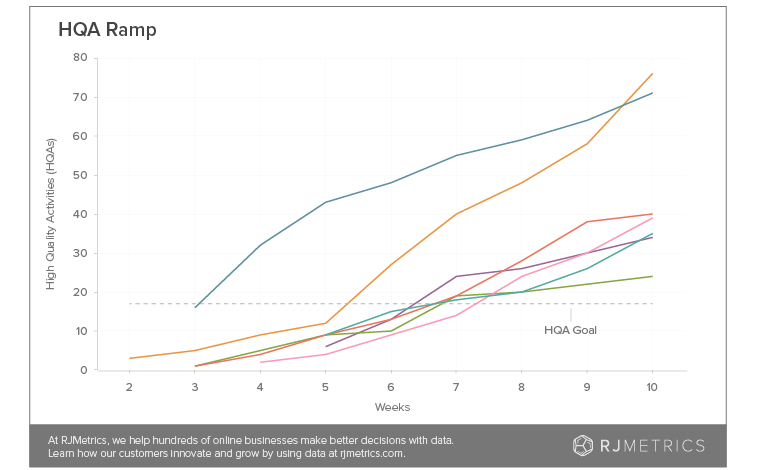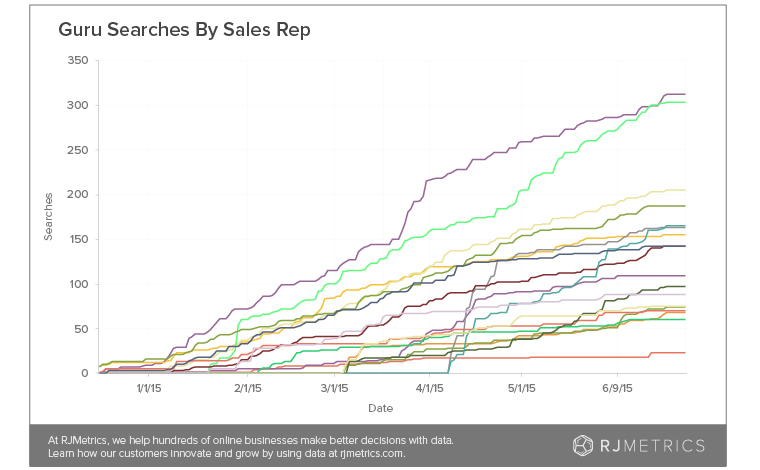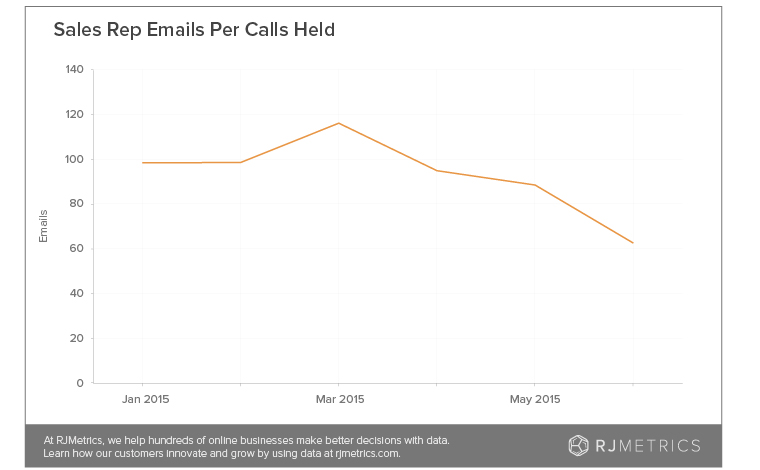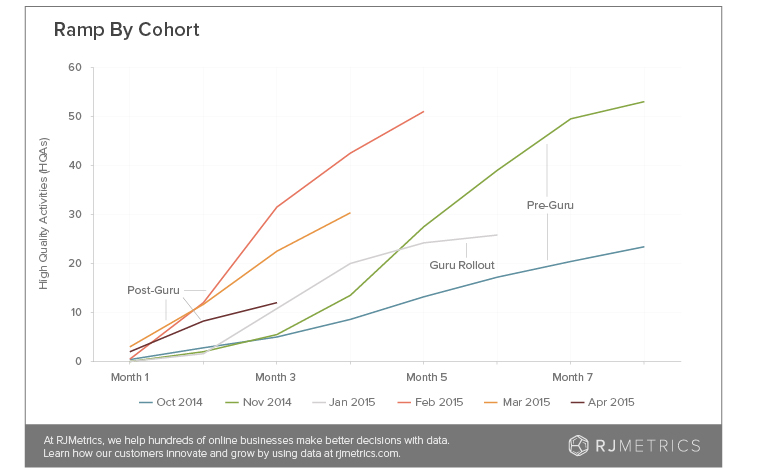Ten months ago I joined the RJMetrics team as the first sales enablement hire. Like most people in these types of roles, I was tasked with a single goal: make our sales team more effective. This meant arming them with the context, knowledge, and tools that would free up their time to do what they do best — sell.
The team was growing incredibly fast, adding 3+ new reps every month. And each new, fully onboarded team member represented thousands of dollars in new revenue.
Onboarding new reps is a major challenge for any sales team — The B2B buyer’s journey is longer and more complicated than ever, and consensus buying decisions have increased the length of these buying cycles upwards of 22%. The growing sophistication of both buyers and products places the onus on reps to respond with a fluid, consultative sales approach, which means new reps have a lot to learn in their first few months on the job.
Our team faces the additional challenge of working in a crowded, confusing landscape; RJMetrics is an analytics platform, and we sit at the crossroads of buzzwords like “data analytics” and “big data”. It’s a complicated, buzzword-laden space. Our goal was to empower new sales reps to be able to successfully navigate this complexity in as little as two months.
So what is sales enablement, anyways?
Before I jump into how we went about this challenge, let me give you some background. The purpose of sales enablement is to keep reps focused on writing emails, answering questions, and taking calls with prospects — not hunting down the information they need to do these things.
In order to empower salespeople with the information they need, sales enablement concentrates on:
- Monitoring changes in the marketplace
- Cataloging available marketing materials
- Determining what content to send and to whom
- Researching competitors and understanding the market trends and buyer needs
- Identifying buying cycle stages
- Staying current on marketing initiatives and product developments
Specific components of sales enablement include:
- Positioning and messaging: Sales reps need to know how to position the product to various personas at different stages of the buying cycle. An understanding of both the competitive landscape and complementary tools is essential when articulating your product’s full value, and how it will solve particular pain points.
- Sales tools and processes: Maximize the value of rep time. Your reps should be concentrating on speed to contact and optimizing the workflows that help them. This can be accomplished through use of CRMs, marketing automation, and additional tools and internal processes.
- Monthly newsletters and updates: Assume your reps are too busy to engage with your content consistently. Sending easily digestible monthly newsletters that outline new processes, product updates, and competitive news will help compress essential information you need delivered to your reps. (My recommended tool for this is Mailchimp. It’s easy to use and allows you to see who is actually reading your emails).
- Scheduled training sessions: Provide recurring training for sales tools, process changes, product releases, and sharing new sales tactics.
- Playbooks and training guides: These training guides are particularly important for new hires. If nothing else, it ensures everyone goes through the same onboarding process and provides a consistent starting point to measure performance from.
- Testing and optimization: From subject lines to email templates – testing and optimizing sales messaging can have a dramatic effect on response rates.
All of these tactics share the single goal of enabling reps to spend their time selling, not acquiring the information necessary to have a meaningful and valuable sales conversation.
Reps, meet Guru
Early on, I recognized two major problems we needed to solve for:
- Our sales team was growing fast. We were having the same inefficient one-off conversations with each new rep over and over again. We needed a better way to ask questions and store/access those answers.
- Our competitive intelligence was growing out of control. We had a growing amount of research on our competition and reps were struggling to keep up.
We needed a way to get new reps up to speed that would also keep more seasoned reps on top of the latest changes in our industry. For us, that tool was Guru.
Guru is a chrome extension that stores information reps can access quickly, so that while they’re sending emails and trying to get people on the phone, they can answer questions faster and smarter.

One of my major concerns before investing in any type of sales enablement tool is time to value. Good sales reps create incredibly efficient workflows, and if I ask them to change up their routine to try a new tool, I need to be confident that they’re going to quickly see value.
There were a few reasons I felt confident that Guru could deliver on this front:
- Guru can replace a myriad of other tools that store sales information (i.e., Google Docs, Slack, Trello, Quandora, etc.). From competitive intelligence to internal marketing docs — we store everything in Guru.
- With its verification functionality, we can ensure each piece of information is trusted and kept up to date.
- If a rep can’t find something he/she is looking for, they simply create a card for it and assign it to an expert, who gets pinged with notifications.
And one of my favorite benefits: data. Guru collects data on how reps are interacting with the tool. Once I pulled that into RJMetrics, I was able to gain quantitative insight on whether or not Guru was helping us.
Measuring success
The biggest success metric of Guru was ramp time for new reps. The better you are at educating new reps on processes, tools, competitors, and content, the faster they ramp to full performance. Makes sense, right?
To see how our reps were ramping, we first needed a clearly defined success metric, and a means to track that success metric over the new hire ramp period. For us, that metric was High Quality Activities (HQA). The inputs for this metric are 1) calls held with prospect and/or 2) handing off a prospect to an account executives. Either of these indicate the prospect is showing purchase intent. Our desired ramp period was eight weeks.
With clear parameters in place, the next step was to benchmark our current performance by looking over previous onboarding data, then creating a goal for our reps. We set the goal at 18 HQAs over a given eight week ramp period.
We then took this goal and our own data, loaded it into RJMetrics, and began analyzing the classes of reps onboarded post-Guru. Here you see each rep represented by individual lines. The gray, dashed line is the 18 HQA goal, and every rep passed with flying colors.

That’s awesome; and was it helping our more senior reps?
Here we see Guru searches by sales reps. As with the HQA chart, there are huge outliers on both ends of the spectrum. I was encouraged to find that the top three Guru-using reps are three of our top performers, but there are a few light Guru users that perform well, too. Overall, it looks like there’s a correlation between Guru engagement and performance, but it’s certainly not the be-all-end-all performance indicators.

Another positive change we saw post-Guru came from our email to call ratio. One of Guru’s main selling points was their ability to provide reps with the information they need to send great emails. We hypothesized that if we increase email quality, reps would be able to get prospects on the phone easier. Here’s what the data showed:

We began rolling out Guru in January. Today, five months later, it takes our reps 37% fewer emails to get a prospect on the phone. This is a win-win for everyone. It makes reps happier and it improves the purchasing experience for our future clients.
While these charts highlight interesting trends, they don’t take into account the extreme outliers that will exist in most cases. Fortunately, we were able to run cohort analysis across the various new rep classes; groups of 3-4 new sales reps that started at the same time. This allowed us to monitor and measure the progress of each class by the cumulative average of HQAs.
Ultimately, if these new classes weren’t improving on average as a group, it would be difficult to suggest we were making meaningful strides. While there are a number of variables that would impact each class, the cumulative average of this success metric should be trending upward as we doubled down on our sales enablement strategy. What we found was incredibly encouraging.
The chart below shows rep cohorts pre-Guru (October, November) and post-Guru (February, March, April). Reps onboarded in post-Guru cohorts were completing 22 HQAs within their first eight weeks. It took reps from earlier cohorts nearly five months to hit this same level of efficiency.

Reps onboarded post-Guru were completing over 9x more HQAs in month two on the job than reps from earlier cohorts, and we had effectively reduced rep onboarding time by three months — roughly a 60% improvement.
How you can make this work for you
Well first, it’s no surprise that I’m a big fan of Guru. It’s played a big role in helping us achieve these incredible results. But that’s not the only thing worth taking away from this post. Here are three of the most important things I’ve learned about implementing any sales enablement tool:
- There’s no magic bullet. Big wins like we had with Guru make for great blog posts, but they’re actually the exception to the rule. Most improvements happen through small, iterative steps. I talked a bit about cohort analysis earlier, and a big reason it’s so valuable for sales enablement is that it helps us measure the cumulative impact of many small changes.
- Use data to guide you. Regardless of how early stage you are, there is tremendous value in collecting as much data as possible. Set yourself up for success early by tracking things as basic as sales performance based on deal size and vertical. Having an ability to bring in multiple sources of data together for analysis is incredibly helpful. Sales enablement is an optimization game, you should always be testing and adjusting.
- Define your success metrics. Have clearly defined success metrics established before making any serious investment in a sales enablement tool. You’ll want these in place down the road when you start getting pushback from veteran reps and senior leadership who will come to you asking if it’s really worth it.
There are growth opportunities everywhere, but the only way to know what’s working is to start collecting data. If you’re interested in learning more about how we enable our sales team, I’m happy to answer any questions in the comments. And if you’d like to learn more about how RJMetrics can help you measure sales performance — get in touch. I’d love to tell you more.
